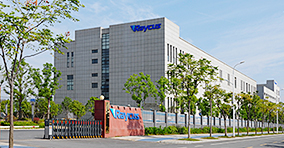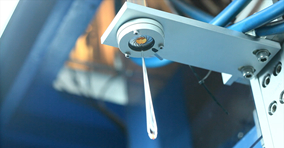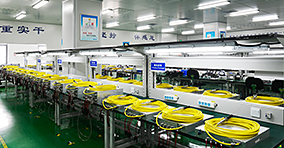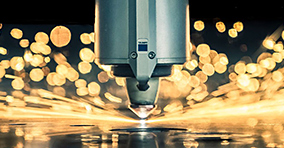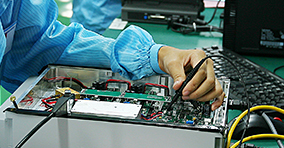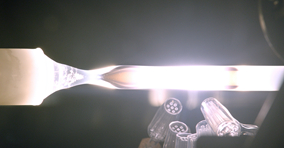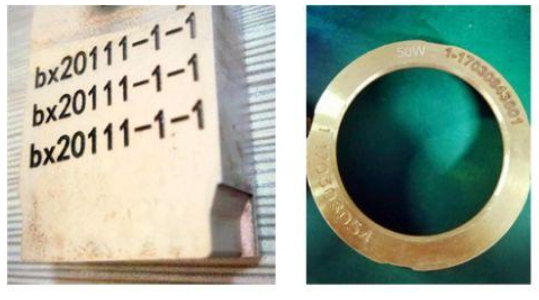In molds, signs, hardware accessories, advertising boards, automobile license plates and other products, traditional corrosion processes not only bring environmental pollution, but also have low efficiency. Machining and other traditional processes for engraving depth, the metal waste and coolant generated will also cause environmental pollution. Although the efficiency is improved, the accuracy is not high, and acute angles cannot be carved. Compared with the traditional method of metal deep engraving, laser metal deep engraving has the advantages of no pollution, high precision, flexible engraving content, and can meet complex engraving techniques.
Common materials for metal deep carving are carbon steel, stainless steel, aluminum, copper, precious metals, etc. Ruike engineers conduct efficient deep carving parameter research for different metal materials.
Deep carving samples
Practical case analysis
The test platform is equipped with RAYLASE (MS-II-10) galvanometer and focusing lens (F = 163/210) for deep carving test. The engraving size is 10mm × 10mm. Set the initial engraving parameters, as shown in Table 1. Change the process parameters such as defocus amount, pulse width, speed, filling interval, etc., and use the deep carving tester to measure the depth to find the process parameters with the best engraving effect.
Table 1 Initial parameters of deep carving
Through the process parameter table, we can see that there are more parameters that affect the final deep carving effect. We use the control variable method to find the process of the effect of each process parameter on the effect. Now we will reveal it one by one.
01 Influence of defocus amount on engraving depth
First, use the RFL-100M laser to engraving the initial parameters, perform engraving experiments on different metal surfaces, repeat the engraving 100 times, the time is 305S, change the defocus amount, and test the influence of the defocus amount on the engraving effect of different materials.
Fig. 1.Comparison of the effect of defocus on the engraving depth of materials.
As shown in Figure 1, we can get the following about the maximum depth corresponding to different defocus amounts when using RFL-100M for deep carving on different metal materials. According to the above data, it is concluded that deep carving on the metal surface requires a certain amount of defocus to obtain the best engraving effect. The defocus amount of carved aluminum and brass is -3mm. The defocus amount of carved stainless steel and carbon steel is -2mm.
02
Effect of pulse width on carving depth
Through the above test, the optimal defocus amount of RFL-100M in deep carving of different materials is obtained. The optimal defocus amount is used to change the pulse width and corresponding frequency in the initial parameters, and other parameters are unchanged. This is mainly because each pulse width of the RFL-100M laser has a corresponding fundamental frequency. When the frequency is lower than the corresponding fundamental frequency, the output power is lower than the average power. When the frequency is higher than the corresponding fundamental frequency, the peak power will be reduced. The engraving test needs to use the largest pulse width and the largest capacity for testing, so the test frequency is the fundamental frequency. The relevant test data will be described in detail in later tests. The fundamental frequency corresponding to each pulse width is: 240ns, 10kHz, 160ns, 105kHz, 130ns, 119kHz, 100ns, 144kHz, 58ns, 179kHz, 40ns, 245kHz, 20ns, 490kHz, 10ns, 999kHz. Carving test was performed with the above pulses and frequencies. The test results are shown in Figure 2.
Figure 2 Comparison of the effect of pulse width on engraving depth
It can be seen from the chart that when engraving RFL-100M, the depth of engraving decreases as the pulse width decreases. At 240ns, the engraving depth of all materials is the largest. This is mainly due to the reduction of the pulse width, which reduces the energy of a single pulse, which in turn reduces the destructive effect on the surface of metal materials, resulting in smaller and smaller engraving depths.
03 the effect of frequency on engraving depth
Through the above tests, the optimal defocus amount and pulse width of RFL-100M when engraving different materials are obtained. The optimal defocus amount and pulse width are used to keep the same. Change the frequency and test the effect of different frequencies on the engraving depth. Test results As shown in Figure 3.
Figure 3 Comparison of the effect of frequency on deep carving of materials
It can be seen from the chart that when the RFL-100M laser is engraving various materials, as the frequency increases, the engraving depth of each material decreases accordingly. When the frequency is 100 kHz, the engraving depth is the largest, and the maximum engraving depth of pure aluminum is 2.43 mm. , Brass is 0.95mm, stainless steel is 0.55mm, and carbon steel is 0.36mm. Among them, aluminum is most sensitive to changes in frequency. When the frequency is 600 kHz, deep carving cannot be performed on the surface of aluminum. While brass, stainless steel, and carbon steel are less affected by frequency, they also show a tendency to increase the depth of engraving as the frequency increases.
04 Effect of speed on engraving depth
Figure 4 Comparison of the effect of engraving speed on engraving depth
It can be seen from the chart that as the engraving speed increases, the engraving depth decreases accordingly. When the engraving speed is 500mm / s, the engraving depth of all materials is the largest. The maximum depth of engraving aluminum, copper, stainless steel and carbon steel is 3.4mm. , 3.24mm, 1.69mm, 1.31mm.
05 Influence of Filling Pitch on Engraving Depth
Figure 5.Effect of filling density on engraving efficiency
It can be seen from the chart that when the filling density is 0.01mm, the engraving depth of aluminum, brass, stainless steel, and carbon steel is the maximum, and the engraving depth decreases correspondingly as the filling gap increases; the filling pitch increases from 0.01mm In the process of 0.1mm, the time required to complete 100 engravings is gradually shortened. When the filling pitch is greater than 0.04mm, the shortening time is significantly reduced.
in conclusion
Through the above tests, we can get the recommended process parameters for deep carving of different metal materials using RFL-100M:


